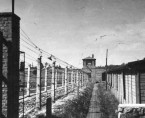Eintrachthütte
A sub-camp in Świętochłowice at the Eintracht mill, part of the Berghütte company. In May 1943 mill management and the SS signed a contract for the rental of one thousand prisoners, to be housed in what had once been a compulsory labor camp for Jews. It was surrounded by a double electrified barbed-wire fence. Inside were six wooden residential barracks and a kitchen, infirmary, storehouse, showers with disinfection chamber, and a latrine. The camp directors were SS men already notorious for their brutality in Auschwitz—SS-Hauptscharführer Josef Remmele and SS-Hauptscharführer Wilhelm Gehring. There were an average of 60 SS men in the garrison, supported at the mill by industrial guards (Werkschutz).
The prisoners, initially Poles in the majority and later Jews as well, worked two shifts, mostly producing components for flak guns and installing mechanisms and barrels from outside suppliers. Some of the prisoners were sub-let to other companies. Working conditions at the lathes, polishing machines, and milling machines would have been tolerable if not for unusually harsh treatment by the SS men. There was even a time when factory management urged the camp authorities to warn the guards not to commit such excesses in the future, especially in the presence of civilian workers.
In May 1944 there was an escape through a 25-meter tunnel that a group of prisoners of various nationalities spent more than a month digging. When they were escaping in groups of three under cover of darkness, a guard raised the alarm from his tower. Several Russians, a Pole, and a Jew got away. An SS investigation yielded no results. In January 1945 there were almost 1,300 prisoners in Eintrachthütte. They were evacuated by train from Świętochłowice to the Mauthausen camp. Several score sick prisoners remained behind in the sub-camp and were liberated there.
